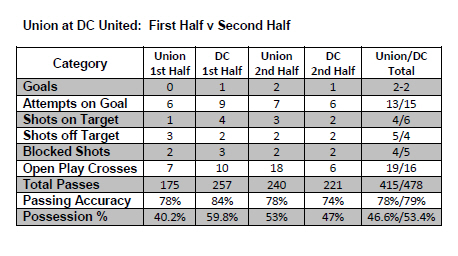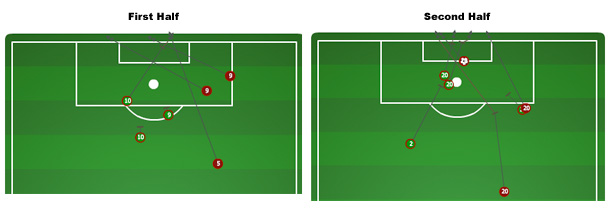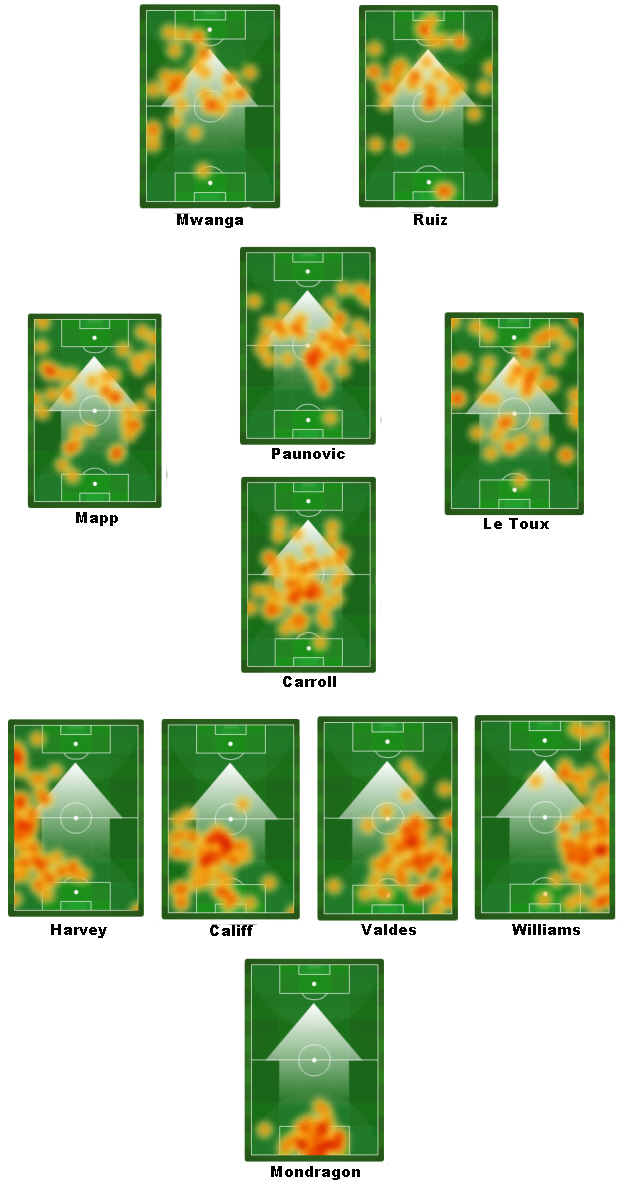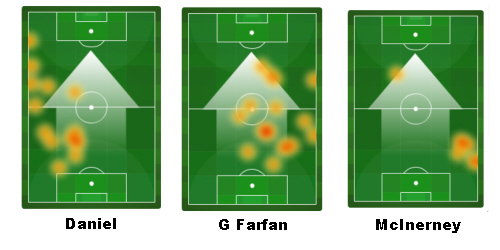For the second game in a row, the Union entered the second half down a goal and battled back with multiple goals—against DC one of their two goals was a Perry Kitchen own goal— to secure points.
Having been out shot, out crossed, as well as out possessed by nearly 20 percent in the first half, the Union took it to DC in the second half.
Better positioning and higher pressure resulted in a sharp reduction of DC’s passing accuracy. Meanwhile, the Union upped the tempo of its passes, adding 65 more than they had recorded in the first half and a 13 percent increase in possession.
Increasing their attempts on goal in the second half seven from their first half tally of six, the Union also increased the number of shots on target in the second half from one to three.
The main factor in this second half increase of production in front of the net?
Carlos Ruiz.
In the first half, Ruiz recorded no attempts on goal. In the second half, he recorded five. Three of those attempts were on target, one of those being the tieing goal in the 84th minute.
In comparison, Sebastien Le Toux recorded three attempts on goal in the first half. Although the finish of his fastbreak in the 36th minute was only inches wide, none of his attempts were on target. In the second half, Le Toux recorded no attempts on goal. But he appeared to be ready to pull the trigger on Paunovic’s chip before Kitchen’s shin beat him to the first equalizer and his perfect pass to Williams led to the final equalizer from Ruiz.
Also in the first half, Valdes shot wide from distance and Mwanga had two attempts including the 19th minute beauty that was net bound save for the timely intervention of Bill Hamid’s fingertips. In the second half, goal attempts from Jordan Harvey and Justin Mapp were both blocked.
Match Statistics
Carlos Ruiz has scored a goal in both games since his return from Gold Cup play, with each goal being a tieing goal.
Getting his eighth start of the season, his first start since Real Salt Lake on June 11, Danny Mwanga was scoreless. Only two of Mwanga’s five goals have come from games that he has started, the two goals he registered against Toronto. All of Mwanga’s goals in 2011 have come in the second half.
It is evident that Veljko Paunovic played further back from the forwards than he did against Chivas. If you look at the sequence that leads to Le Toux’s 36th minute fastbreak, for example, it begins with Paunovic dispossessing Dwayne De Rosario with some help from Danny Calff at midfield about midway in the Union half. Paunovic carries the ball a few touches before passing to Ruiz. Ruiz lays the ball off for Paunovic who then delivers the ball through the DC backline to the feet of a charging Le Toux. A really lovely sequence and it is a pity Le Toux was unlucky with his finish.
 The three substitutions—Gabriel Farfan, Keon Daniel and Jack McInerney—recorded no shots. In his 24 minutes of play, Garfan made nine successful passes and three unsuccessful passes. For Daniel, it was eight successful passes and four unsuccessful passes in 19 minutes of play. On the field for but 12 minutes, McInerney recorded three successful passes and two unsuccessful passes.
The three substitutions—Gabriel Farfan, Keon Daniel and Jack McInerney—recorded no shots. In his 24 minutes of play, Garfan made nine successful passes and three unsuccessful passes. For Daniel, it was eight successful passes and four unsuccessful passes in 19 minutes of play. On the field for but 12 minutes, McInerney recorded three successful passes and two unsuccessful passes.
Turning the ball over cheaply?
Watching the game it seemed to me that, particularly in the first half, that the Union were turning the ball over very cheaply. With that in mind, I thought it might be interesting to look at the passing numbers of the backline and midfield.
Harvey was subbed out at the start of the second half against Chivas, a decision that makes sense in terms of the number of unsuccessful passes, which was at 40 percent. The number of unsuccessful passes against DC dropped significantly to 29 percent. This was true almost across the board with numbers ranging from Califf’s unsuccessful percentage of 32 percent against Chivas significantly improving to 18 percent against DC to the more modest improvement of Sheanon Williams with 29 percent against Chivas and 25 percent against DC.
Two starters showed a dip in passing form. Against Chivas, 23 percent of Valdes’ passes were unsuccessful while, against DC, the number was 26 percent. Le Toux seems to have the highest regular percentage of unsuccessful passes. Against Chivas, 43 percent were unsuccessful. Against DC, 44 percent were unsuccessful.
Were the Union turning the ball over cheaply? That may be impossible to tell from the passing numbers; cheap turnovers are based on the given situation. But, generally speaking, the Union seemed to have had a better day in terms of passing against DC than they did against Chivas.
Heat map: Favoring the right?
One of the fun new features of the information available through the Chalkboard tab at MLSsoccer.com’s MatchCenter is the heat map. Through the heat map you can get a sense of where each player is active on the pitch. Le Toux and Mapp, for example, are everywhere, although Le Toux is more willing to break into the box. Against DC, at least, Paunovic did seem to spend more time in the middle third of the field.
If you were looking at the heat maps, as well as the attempts on goal diagrams above, and hadn’t actually watched the game, it seems to me that it would be easy for an impression to form: the Union favor attacking from the right.







